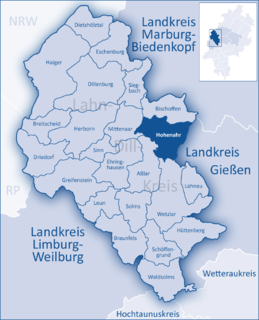Lahn-Dill is a Kreis (district) in the west of Hesse, Germany. Neighboring districts are Siegen-Wittgenstein, Marburg-Biedenkopf, Gießen, Wetteraukreis, Hochtaunuskreis, Limburg-Weilburg, Westerwaldkreis.
Marburg-Biedenkopf is a Kreis (district) in the west of Hesse, Germany. Neighboring districts are Waldeck-Frankenberg, Schwalm-Eder, Vogelsbergkreis, Gießen, Lahn-Dill, Siegen-Wittgenstein.

Dautphetal is a community in Hesse, Germany, and is among the six larger communities of the 22 in Marburg-Biedenkopf district.

The community of Lahntal is found in the Marburg-Biedenkopf district in northwest Middle Hesse, Germany.

Leun is a small town in the Lahn-Dill-Kreis in Hesse, Germany.

Angelburg is a community in western Marburg-Biedenkopf in northwest Middle Hesse in Germany.

Gladenbach [German pronunciation: [ˈɡlaːdn̩ˌbax](listen)] is a town in Hesse, Germany, in the west of Marburg-Biedenkopf district.

Lohra is a community in Marburg-Biedenkopf district in the administrative region of Gießen in Hesse, Germany.

Bad Endbach is the westernmost municipality in Marburg-Biedenkopf district of the state of Hesse in Germany, and borders on the Lahn-Dill district.

The Dill is a 55 km (34 mi) long river, flowing through central Hesse in Germany. It is a tributary to the Lahn, joining it on the right bank at the town of Wetzlar.

The municipality of Dietzhölztal is the northernmost municipality in the Lahn-Dill-Kreis in Hesse, Germany.

Hohenahr is a municipality in the Lahn-Dill-Kreis in Hesse, Germany.

Mittenaar is a municipality in the Lahn-Dill-Kreis in Hesse, Germany.

Schöffengrund is a community in the Lahn-Dill-Kreis in Hesse, Germany.

Siegbach is a municipality in the Lahn-Dill-Kreis in Hesse, Germany.

Sinn is a community in Middle Hesse, Germany, in the Lahn-Dill-Kreis.

The Gladenbach Uplands, named after their central town of Gladenbach, is a range of hills up to 609 m high in the Rhine Massif in Germany, on the junction of the Rothaar Mountains, Westerwald (southwest), (Eastern) Hintertaunus and West Hesse Highlands in the east. It lies in Central Hesse within the districts of Marburg-Biedenkopf, Lahn-Dill and Gießen within the so-called Lahn-Dill-(Dietzhölze-) loop. Small parts of the Upper Lahn Valley in the northwest belong, together with the town of Bad Laasphe, also to the district of Siegen-Wittgenstein, North Rhine-Westphalia.

The Aar Dam and its reservoir, the Aartalsee, lie in the upper Aar valley in the German state of Hesse. Both are in the municipalities of Bischoffen and Hohenahr in the county of Lahn-Dill-Kreis and about 15 km northwest of the town of Gießen in Hesse. On the lakeshores lie the villages of Ahrdt and Mudersbach, both part of the parish of Hohenahr. Since 1991 the dam has impounded the River Aar, a left-hand tributary of the Dill in the Gladenbach Uplands. The reservoir is also fed by the Stadterbach, Wilsbach, Weidbach and Meerbach.

The land known as the Hessian Hinterland lies within the region of Middle Hesse and is concentrated around the old county of Biedenkopf, that is the western part of the present county of Marburg-Biedenkopf, as well as elements of the present-day counties of Lahn-Dill-Kreis and Waldeck-Frankenberg. Formerly it snaked its way from Bromskirchen in the north to Rodheim, in the municipality of Biebertal.






















